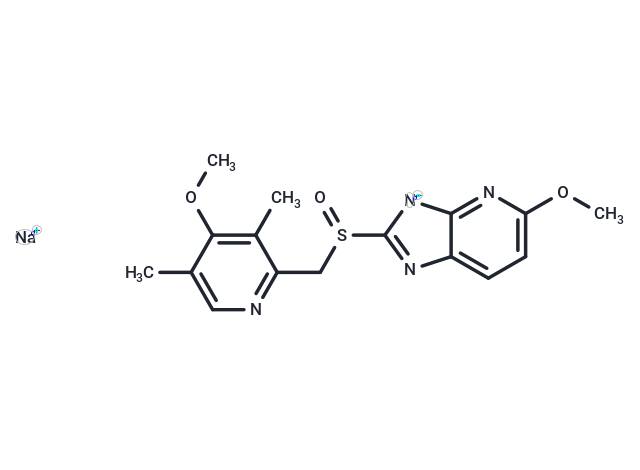Shopping Cart
Remove All Your shopping cart is currently empty
Your shopping cart is currently empty
Tenatoprazole sodium (TU-199 sodium) is a potent proton pump inhibitor that suppresses hog gastric H+/K+-ATPase activity, a key enzyme in acid secretion, with an IC50 value of 6.2 μM.

| Pack Size | Price | USA Warehouse | Global Warehouse | Quantity |
|---|---|---|---|---|
| 25 mg | $1,520 | 1-2 weeks | 1-2 weeks | |
| 50 mg | $1,980 | 1-2 weeks | 1-2 weeks | |
| 100 mg | $2,500 | 1-2 weeks | 1-2 weeks |
| Description | Tenatoprazole sodium (TU-199 sodium) is a potent proton pump inhibitor that suppresses hog gastric H+/K+-ATPase activity, a key enzyme in acid secretion, with an IC50 value of 6.2 μM. |
| In vitro | Tenatoprazole, a prodrug in the proton pump inhibitor class, demonstrates inhibition of gastric H+/K+-ATPase activity in pigs with potency nearly equivalent to omeprazole, exhibiting IC50 values of 6.2 and 4.2 microM, respectively [1]. Upon activation by stomach acid in the secretory canaliculus of stimulated parietal cells, tenatoprazole transforms into an active sulfenamide or sulfenic acid. This active form establishes a disulfide bond with accessible cysteine residues on the gastric H+/K+-ATPase, effectively halting acid secretion. Notably, tenatoprazole associates with the acid pump's catalytic subunit with a binding ratio of 2.6 nmol per mg of enzyme [2]. |
| In vivo | Tenatoprazole effectively inhibits basal gastric acid secretion in pylorus-ligated rats in a dose-dependent manner, with an ED 50 value of 4.2 mg/kg orally. Additionally, at doses of 2.5 and 5 mg/kg intraduodenally, it suppresses gastric acid secretion induced by histamine, carbachol, or tetragastrin in gastric fistula rats. It also protects against various gastric and duodenal lesions induced by stress, pylorus ligation, indomethacin, and mepirizole. Notably, tenatoprazole achieves maximum enzyme binding of 2.9 nmol/mg 2 hours after intravenous administration, with binding sites located in the TM5/6 region at Cys813 and Cys822. The bioavailability of tenatoprazole is significantly enhanced in the (S)-tenatoprazole sodium salt hydrate form, showing a two-fold increase compared to its free form in dogs. |
| Molecular Weight | 368.39 |
| Formula | C16H17N4NaO3S |
| Cas No. | 335299-59-7 |
| Smiles | [Na+].COc1ccc2nc([n-]c2n1)S(=O)Cc1ncc(C)c(OC)c1C |
| Storage | Powder: -20°C for 3 years | In solvent: -80°C for 1 year | Shipping with blue ice/Shipping at ambient temperature. |
| Size | Quantity | Unit Price | Amount | Operation |
|---|

Copyright © 2015-2026 TargetMol Chemicals Inc. All Rights Reserved.